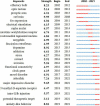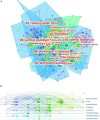Habenula bibliometrics: Thematic development and research fronts of a resurgent field
- PMID: 35990593
- PMCID: PMC9382245
- DOI: 10.3389/fnint.2022.949162
Habenula bibliometrics: Thematic development and research fronts of a resurgent field
Abstract
The habenula (Hb) is a small structure of the posterior diencephalon that is highly conserved across vertebrates but nonetheless has attracted relatively little research attention until the past two decades. The resurgent interest is motivated by neurobehavioral studies demonstrating critical functions in a broad spectrum of motivational and cognitive processes, including functions relevant to psychiatric diseases. The Hb is widely conceived as an "anti-reward" center that acts by regulating brain monoaminergic systems. However, there is still no general conceptual framework for habenula research, and no study has focused on uncovering potentially significant but overlooked topics that may advance our understanding of physiological functions or suggest potential clinical applications of Hb-targeted interventions. Using science mapping tools, we quantitatively and qualitatively analyzed the relevant publications retrieved from the Web of Science Core Collection (WoSCC) database from 2002 to 2021. Herein we present an overview of habenula-related publications, reveal primary research trends, and prioritize some key research fronts by complementary bibliometric analysis. High-priority research fronts include Ventral Pallidum, Nucleus Accumbens, Nicotine and MHb, GLT-1, Zebrafish, and GCaMP, Ketamine, Deep Brain Stimulation, and GPR139. The high intrinsic heterogeneity of the Hb, extensive connectivity with both hindbrain and forebrain structures, and emerging associations with all three dimensions of mental disorders (internalizing, externalizing, and psychosis) suggest that the Hb may be the neuronal substrate for a common psychopathology factor shared by all mental illnesses termed the p factor. A future challenge is to explore the therapeutic potential of habenular modulation at circuit, cellular, and molecular levels.
Keywords: bibliometric; circuit; depression; habenula; p factor; therapeutic target.
Copyright © 2022 Chen, Sun, Zhang, Mu and Su.
Conflict of interest statement
The authors declare that the research was conducted in the absence of any commercial or financial relationships that could be construed as a potential conflict of interest.
Figures






References
-
- Ahrens M. B., Orger M. B., Robson D. N., Li J. M., Keller P. J. (2013). Whole-brain functional imaging at cellular resolution using light-sheet microscopy. Nat. Methods 10 413–420. - PubMed
LinkOut - more resources
Full Text Sources
Miscellaneous

